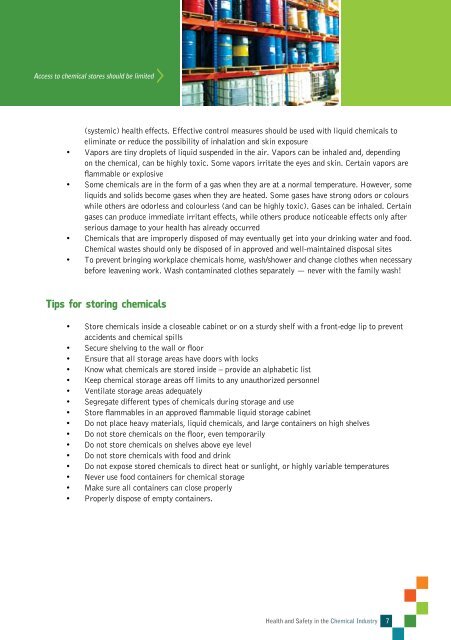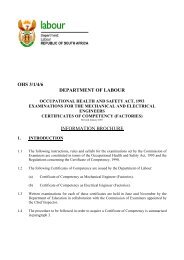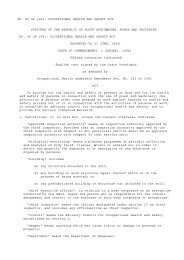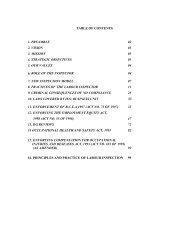Health and Safety in Chemical Industries.pdf - Department of Labour
Health and Safety in Chemical Industries.pdf - Department of Labour
Health and Safety in Chemical Industries.pdf - Department of Labour
Create successful ePaper yourself
Turn your PDF publications into a flip-book with our unique Google optimized e-Paper software.
Access to chemical stores should be limited<br />
(systemic) health effects. Effective control measures should be used with liquid chemicals to<br />
elim<strong>in</strong>ate or reduce the possibility <strong>of</strong> <strong>in</strong>halation <strong>and</strong> sk<strong>in</strong> exposure<br />
• Vapors are t<strong>in</strong>y droplets <strong>of</strong> liquid suspended <strong>in</strong> the air. Vapors can be <strong>in</strong>haled <strong>and</strong>, depend<strong>in</strong>g<br />
on the chemical, can be highly toxic. Some vapors irritate the eyes <strong>and</strong> sk<strong>in</strong>. Certa<strong>in</strong> vapors are<br />
flammable or explosive<br />
• Some chemicals are <strong>in</strong> the form <strong>of</strong> a gas when they are at a normal temperature. However, some<br />
liquids <strong>and</strong> solids become gases when they are heated. Some gases have strong odors or colours<br />
while others are odorless <strong>and</strong> colourless (<strong>and</strong> can be highly toxic). Gases can be <strong>in</strong>haled. Certa<strong>in</strong><br />
gases can produce immediate irritant effects, while others produce noticeable effects only after<br />
serious damage to your health has already occurred<br />
• <strong>Chemical</strong>s that are improperly disposed <strong>of</strong> may eventually get <strong>in</strong>to your dr<strong>in</strong>k<strong>in</strong>g water <strong>and</strong> food.<br />
<strong>Chemical</strong> wastes should only be disposed <strong>of</strong> <strong>in</strong> approved <strong>and</strong> well-ma<strong>in</strong>ta<strong>in</strong>ed disposal sites<br />
• To prevent br<strong>in</strong>g<strong>in</strong>g workplace chemicals home, wash/shower <strong>and</strong> change clothes when necessary<br />
before leaven<strong>in</strong>g work. Wash contam<strong>in</strong>ated clothes separately — never with the family wash!<br />
Tips for stor<strong>in</strong>g chemicals<br />
• Store chemicals <strong>in</strong>side a closeable cab<strong>in</strong>et or on a sturdy shelf with a front-edge lip to prevent<br />
accidents <strong>and</strong> chemical spills<br />
• Secure shelv<strong>in</strong>g to the wall or floor<br />
• Ensure that all storage areas have doors with locks<br />
• Know what chemicals are stored <strong>in</strong>side – provide an alphabetic list<br />
• Keep chemical storage areas <strong>of</strong>f limits to any unauthorized personnel<br />
• Ventilate storage areas adequately<br />
• Segregate different types <strong>of</strong> chemicals dur<strong>in</strong>g storage <strong>and</strong> use<br />
• Store flammables <strong>in</strong> an approved flammable liquid storage cab<strong>in</strong>et<br />
• Do not place heavy materials, liquid chemicals, <strong>and</strong> large conta<strong>in</strong>ers on high shelves<br />
• Do not store chemicals on the floor, even temporarily<br />
• Do not store chemicals on shelves above eye level<br />
• Do not store chemicals with food <strong>and</strong> dr<strong>in</strong>k<br />
• Do not expose stored chemicals to direct heat or sunlight, or highly variable temperatures<br />
• Never use food conta<strong>in</strong>ers for chemical storage<br />
• Make sure all conta<strong>in</strong>ers can close properly<br />
• Properly dispose <strong>of</strong> empty conta<strong>in</strong>ers.<br />
<strong>Health</strong> <strong>and</strong> <strong>Safety</strong> <strong>in</strong> the <strong>Chemical</strong> Industry 7

















